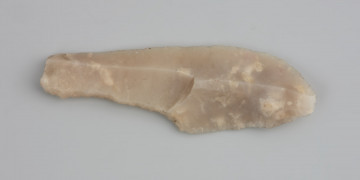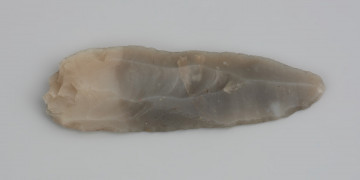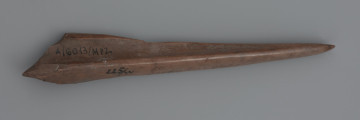
Single-jagged edge
11900 p.n.e. — 11000 p.n.e.
National Museum in Szczecin
Part of the collection: Stone Age
The conical core was found near Drzewica, the Kamień district, probably at the end of the 19th century, and bought by Gesellschaft für Pommersche Geschichte und Altertumskunde from Loth in Sassnitz in 1896. The core, a lump of flint designed and prepared for breaking off half-silver then used to manufacture tools, has a circular splinter with 12 negatives of long, straight chips. Originally, it was much larger, but as it was exploited, its circumference reduced. The core heel, i.e., the surface struck, was carefully freshened, i.e., adjusted so that the correct angle between the heel and the splint was maintained. The freshening of the heel is typical of the technological traditions of the people of the eastern Baltic region. Transformations in the technology of obtaining semi-raw material for tool making, involving the so-called intermediary, mark the middle Mesolithic period. The technique consists of using antler or bone as an intermediary between the core and the pestle. Obtaining long, straight, and regular blades was easier this way than with a direct blow with a hard or soft pestle.
Michał Adamczyk
Author / creator
Dimensions
cały obiekt: height: 8.4 cm, width: 4.3 cm
Object type
lithic core, production waste
Technique
intermediary carving, carving, hard masher carving
Material
flint, stone
Origin / acquisition method
acquisition
Creation time / dating
Creation / finding place
Owner
National Museum in Szczecin
Identification number
Location / status

11900 p.n.e. — 11000 p.n.e.
National Museum in Szczecin

11900 p.n.e. — 11000 p.n.e.
National Museum in Szczecin

9600 p.n.e. — 4100 p.n.e.
National Museum in Szczecin
DISCOVER this TOPIC
Castle Museum in Łańcut
DISCOVER this PATH
Educational path